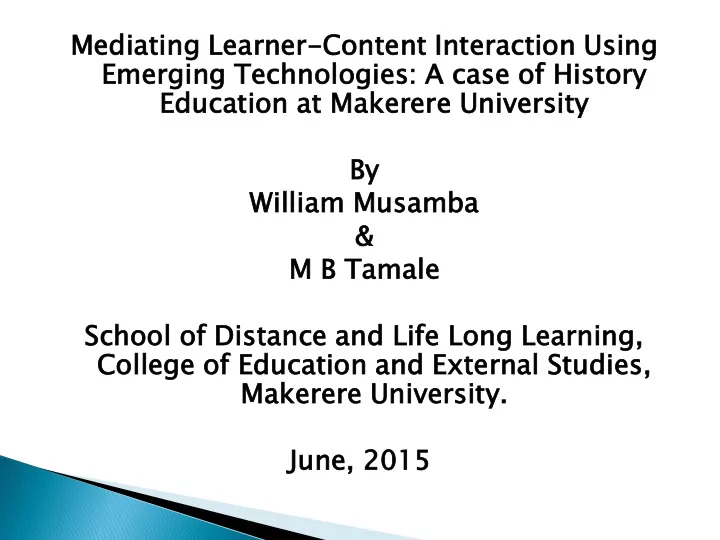

Med ediating ating Lea earner rner-Cont Conten ent Interaction eraction Using g Emergin rging g Technol ologi ogies es: : A case of Hi History ry Educ ucation ation at Maker erere ere Unive vers rsity ty By By Wi William Musamba amba & M B Ta B Tama male School ol of Distanc ance e and Life Long g Learning, rning, Colleg ege e of Education ation and External ernal St Studies, ies, Makerer kerere e Unive versity. rsity. June, ne, 2015 2015
Initial stages of ICT integration in Uganda’s teaching-learning process (Ali, Haoulader &Muhammad, 2013). Lukewarm usage of ICT in Makerere university ;(Muyinda, 2009, Bakkabulindi, 2012) Presence of continuous commitment to support innovations in institutions of higher learning. Potential of ICT integration in education changing worldview and lifestyle at the all levels, a phenomenon called Technology Mediated Learning (TML) (Feuerstein, 2006).
The problem of inert knowledge with its characteristic of rote learning, are central concerns in most of today’s researches, yet none focuses on history education where students basically cram notes to pass exams rather than understanding (Lauwerier, T. and Akkari, A. 2015). Aim im Empirically investigated ways through which improvements can be made in History Education using Emerging Technologies.
The theory of Online Learning (Anderson 2008) underpinned this study. Six levels of interaction: Learner-content, Learner-learner, Learner- instructor, Content-content, Instructor-content and Instructor-instructor. Recent studies such as Tsang (2010), Zimmerman (2012), Shackelford (2012) have concentrated on the general role of technology in enhancing online learning, but remained silent on the role of Emerging Technologies in mediating learner-content interaction in History Education. Emerging technologies have potential enhance Learner-content interaction. Informed by the theory of online learning, this study proposed that the use of emerging technologies by history education students in Makerere University could be related to the way learners manipulate these technologies to maximize opportunities for learner-content interaction leading to cognitive development.
Conceptual framework Depend endent ent Indepe epend ndent ent vari riables es vari riable Extra rane neous ous Learner-content vari riables es Emergin rging Interaction Tech chno nologi ogies es • Discussion • Content exploration Government policy • Content analysis University Policy Social networking • Content interpretation NGOs sites Religious institutions Blogging tools Community Wikis More technologies
Ob Object ective ve Explore the role of Emerging Technologies in mediating Learner-Content Interaction in History Education so as to remain relevant.
Thurmond (2003) defined interaction as the learner’s engagement with the course content, other learners, the instructor, and the technological medium used in the course. Anderson (2008) identified six forms of interaction which include Teacher-Teacher, Learner-Teacher, Learner-Learner, Learner-Content, Content- Content and Teacher-Content. Kanuka (2011) defined Learner-Content interaction as an intellectual participation between the learner and the subject matter. No focus on emerging technologies and learner- content interaction in history education.
Quantitative approach and correlational survey design. 233 students. A self-administered questionnaire with a section on learner-content interaction (nine items: α = 0.92). Morgan and Krejcie’s Sample Size Estimation Table. Five-point Likert for the minimum. Pearson Correlation Moment Index goodness of fit test, at the confidence level equals .05.
64% of students agreed that with emerging technologies, they were able to discover more knowledge in history education than when they simply listen to a lecture; 65% felt that emerging technologies have the potential to offer them opportunities for interaction among themselves as students of history education; 58% of the respondents agreed that emerging technologies enhances their intellectual transformation; 65% concurred with the measurement that emerging technologies has the potential to keep history education students preparedness and more involvement. All other items scored “Agree”, implying that Emerging Technologies enhances Learner-Content interaction.
Integration of Emerging Technologies like blog pages, Google Docs, wikis, Skype, and the rest have a positive relationship with learner content interaction. The more these emerging technologies are applied in the teaching and learning process students get more friendly to them, utilize them constantly, share and discover more knowledge, hence its relevancy to the teaching and learning activity, basing on the theory of Online Learning.
Enhance uptake of learner-content interactions among history education students at School of Education in Makerere University through use of Emerging Technologies Liaise with relevant partners (ICT Directorate, ODeL, MUELE, Library, Directorate of Research etc. )
Questions & Comments are Welcome Thank you.
Recommend
More recommend